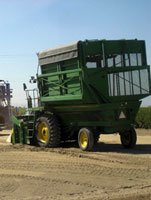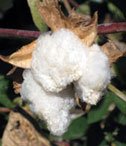Looking at Sustainable From a Conventional-Cotton Perspective
How will the cotton industry evolve to become more sustainable? The question of cotton’s future brought together academics, retailers, farmers and scientists at Cotton Inc.’s recent Sustainability Summit, held earlier this year at California’s Yosemite National Park.
“Organic” is a limited term that doesn’t adequately address spent energy and resources.
A natural fiber’s environmental footprint does not stop at the farm level. This is a lifecycle issue that extends through the entire supply chain of a product and into its usage and disposability.
Eco-certification and standards are under way throughout the apparel supply chain and include both environmental and social aspects of trade and manufacturing around the globe.
Brands and retailers are leading the way toward supply-chain improvement, making transparency the future of the retail supply chain.
Sustainable methods are now at the core of business as cost-saving and branding measures and should not be considered a side project.
Technology is the driver behind more eco-friendly agriculture and manufacturing, finding alternative fuel sources, and reducing the environmental footprint.
Cotton: organic vs. conventional
In the apparel industry, the biggest green story is organic cotton, but what does it mean?
The U.S. Department of Agriculture insists that cotton labeled as organic must come from natural, non-engineered cotton seed and be grown with no synthetic fertilizers and only approved types of herbicides and pesticides, among other standards. Government certification, however, stops on the farm. It does not include standards for production, so that cotton marked “100 percent organic” might have been spun into fabric dyed with toxic chemicals.
But the real debate between organic and conventional cotton is whether organic farming methods are actually more environmentally friendly than those that are technologically enhanced.
The debate mostly rests on genetically modified seed (GMO), which is bioengineered for much larger yields of cotton and less water consumption. While organic cotton has the commercial benefit of being more aligned with natural methods, engineered seeds produce more cotton using fewer natural resources.
“I have never seen a single study that said GMOs have a harmful effect,” said Richard Blackburn, head of Green Chemistry Research at the University of Leeds. That’s not to say that bioengineering should be viewed without suspicion, but even so, organic farming, as currently defined, is still not sustainable at a mass level.
“To grow something organically, you can’t get the same yield, and organic can’t go beyond a niche. I can understand the pesticide issue, but a lot of the reasons that people in India and China have a problem with pesticide is that they’re not paid very much; they can’t afford face masks and protective clothing, which is where fair trade helps out,” Blackburn said.
Cotton farming is vastly different in the United States, which has seen a significant reduction in chemical usage, run-off and pesticide usage in conventional cotton farming since 1990 compared with developing countries, where farmers may be underserved.
Cotton farming still requires tremendous amounts of water, but the issue is not so much about eliminating waste altogether but about eliminating waste to a significant extent across the supply chain and around the world.
Precision agriculture is one of the most important changes serving U.S. farmers today. V. Larkin Martin, who runs a family-owned farm in Alabama, uses satellite-enabled GPS technology to create maps from soil samples and treat the fields accordingly. “I can show a sourcing agent exactly what went on my field and where I can create transparency,” said Martin, who grows conventional cotton.
Technology today is driving research on better cotton practice, with genetic modification being tested to make cotton seed safe for animal feed and garments anti-microbial for less laundering.
As for fiber alternatives, it’s still a question of balance. Lyocell (branded as Tencel in the United States) is a regenerated fiber, so it often gets lumped with synthetics, but the fiber’s raw material is the wood pulp from trees such as the eucalyptus. Trees don’t require as much water and very little fertilizer compared with cotton plants, but they also take significantly longer to grow, and the process of breaking down a stiff, fibrous material is far from chemical-free.
Global standards
“The cotton industry came to us, the government, and said, ’We want you to regulate us,’ which is incredible,” said Mark Bradley, associate deputy administrator of the USDA’s National Organic Program (NO P).
But regulating is a path to ensure that integrity does not go unnoticed. “We have two primary functions: to maintain the relevance of standards and to protect the brand,” said Bradley.
While processing standards are not currently taken into account under the NOP, people such as Johan Maris, managing director at Control Unions Certifications, are looking to create broader certification at an international level. “We are transforming our standards from EKO to the Global Organic Textile Standard (GOTS), which includes dye requirements, haberdashery, the impact of production on the environment and social aspects.”
The Better Cotton Initiative, established to promote more-sustainable cultivation practice, is being supported by major retailers to make cotton’s long supply chain more transparent. Retailers agree that better standards will create better branding opportunities.
“Organic will only ever be a niche, and I can’t explain everything technical to my customers, so we need a better standard,” said sustainable textiles and cotton specialist Graham P. Burden of Marks & Spencer.
Environmental challengesAs founder of Sustainability Partners Inc., Brian Nattrass counts the U.S. Army as one of his biggest clients. Why? “They understood the relationship between security and sustainability; there is no global security without sustainability, and vice versa,” he said.
Water scarcity, a growing world population, depleted fuel reserves, unequal wealth distribution and a shifting climate—these are issues that threaten global security and sustainable lifestyles.
There are a variety of stakeholders pushing environmental responsibility, not just NGOs but investors and brands, said Winston Eco-Strategies founder Andrew Winston. Value-chain thinking is driving much of the corporate world’s support for sustainable action. Consider aluminum manufacturer Alcoa’s decision to join the U.S. Climate Action Partnership, which supports national legislation for cutting greenhouse-gas emissions. The environmental push toward lighter vehicles will create a better market for aluminum, Winston said.
Then there’s branding. Besides making green changes to increase brand prestige, companies are discovering that not knowing their supply chains can lead to critical losses such as product recalls. Interconnectivity and consumer awareness is lending more transparency to the production cycle.
Wal-Mart’s new scorecard asking suppliers to rate their energy usage, Winston said, is an indication that more shelf space will be going to “greener” products. Although the consumer is currently conflicted about when and how to make environmental decisions, retail is moving toward more-responsible consumption that actually removes the burden of decision making.Green methods can no longer be thought of as a pet project; they are core to the efficiency and productivity of big business. “Over the last 15 years, DuPont drastically reduced waste reduction, held energy use flat. hellip; Their eco-efficiency of $1.9 billion was actually equivalent to their average net income,” Winston said.
Recycling, although it requires a tremendous infrastructure within a brand or retailer, ought to be considered creatively as well. Dell, for example, recycles used computers and, in so doing, builds a better relationship with its customer, who, at the recycling stage, is looking to buy again.
With sustainability becoming a major priority, new risks will threaten product categories from out of left field. Winston gave the example of a video conferencing system that boasts eco-friendliness because it cuts down on the need to travel. That’s unlikely competition for airlines.
Retail response: Marks & Spencer, Wal-Mart, Nike
Marks & Spencer
United Kingdom–based retailer Marks & Spencer has engaged in massive business with fair-trade cotton based on the retailer’s Plan A Initiative, launched in January 2007, which takes five factors into account: climate, waste, sustainable materials, fair partnerships and health.
Its cotton strategy has committed M&S to selling 20 million garments and working with 10,000 farmers in West Africa and India, purchasing cotton at a fixed price in addition to paying an investment premium.
The “Fairtrade” mark is a certified one that guarantees a better deal for third-world producers, which will translate easily to consumers. The retailer uses 80,000 tons of cotton per year, which makes up 55 percent of its clothing. M&S recently launched its pound;5 (equivalent U.S. $10.28) cotton T-shirt, well aware that it would take a hit on the price.
“The point in doing this is that you have to engage yourself much more directly with the very beginnings of the textile supply chain,” said Graham P. Burden. The ’Fairtrade’ seal is expected to have the same impact of transparency that brightly marked, front-of-package food labels have at M&S stores.
And why not turn supply-chain transparency into storytelling? Burden is also interested in knowing the particular histories of cotton farmers in the United States, for example. “Imagine being able to say, ’this is seventh-generation cotton; the family has been on the land since 1817,’” said Burden.
M&S is also working with suppliers in Sri Lanka to develop an eco-factory and now plans to sell 400,000 recycled polyester garments by combining piece-dyed polyester fabric with the strong polymers found in used plastic water bottles.Wal-Mart
In October 2005, Wal-Mart executives declared sustainability to be the gateway toward better business practice. Three goals were established: to be supplied by 100 percent renewable energy, create zero waste and sell products that sustain resources and the environment.
The Bentonville, Ark.–based chain’s 14 Sustainability Value Networks engage suppliers, experts and NGOs in developing new ways to cut energy, which has become a bottom-line strategy to cutting costs. Right now, stores are rolling out freezer doors that cut energy usage by 70 percent, and motion-sensing lights are already cutting use by 45 percent.
In 2006, Wal-Mart launched the Sustainable Textile Network to look into the garment supply chain and, more recently, the brand’s supplier scorecard rates seven of its key suppliers on the following: energy efficiency, water use, chemical inputs, recycling and reuse, social responsibility, and packaging.
“If it goes well, we will launch the scorecard to all textile suppliers next year,” said Kim Brandner, corporate brand manager of sustainable textiles at Wal-Mart.Nike
Beaverton, Ore.–based Nike’s corporate-responsibility strategy consists of four parts: responsible competitiveness; considered design; climate neutrality; and “let me play,” a community program to encourage young people to participate in sports. One result was “Nike Considered,” a design philosophy combining innovation and sustainability with a dedicated design team. “Cotton is not an easy issue; organic cotton won’t always score as well as conventional,” said Sarah Severn, Nike’s director of Sustainability Horizons. The scorecard rates products for waste reduction, healthy chemistry and innovation at bronze, silver and gold levels. “Only at the gold level do we talk about the product to the consumer. By 2011 we want everything at least bronze level,” said Severn.
Nike has already engaged in recycling, taking active footwear of any brand and recycling it into sports surfaces. “We are about to do a big push for New Orleans,” said Severn.
Trends that the brand feels are important for the next 5 to 10 years include “new activism,” putting pressure on social justice and environmental impact. Global activism may seem a niche market now, but Severn said that the “true greens” are leading value changes.
“The past point of resistance was that the consumer was not asking for this, but that’s not strictly true. We create the market.”

























